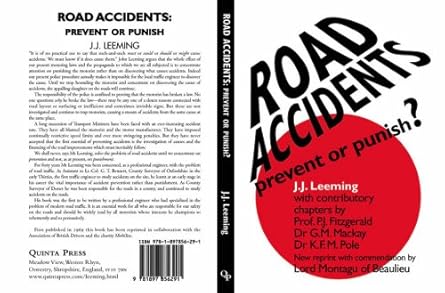
“Road Accidents: Prevent or Punish?” by J.J. Leeming, first published in 1969, is a seminal work by a British civil engineer and traffic expert who challenges the prevailing approach to road safety.
Drawing on his extensive experience as County Surveyor of Dorset and his earlier work in Oxfordshire, Leeming argues that the focus of motoring laws and policies on punishing drivers is misguided and ineffective. Instead, he advocates for a preventative approach rooted in understanding the true causes of accidents through scientific analysis and road engineering solutions.
Leeming’s central thesis is that the “blame culture” surrounding road accidents—where drivers are almost automatically held accountable—obscures the real factors contributing to collisions.
He asserts that simply punishing motorists does little to reduce accident rates and may even hinder efforts to identify and address underlying issues. He famously states, “It is of no practical use to say that such-and-such must or could or should or might cause accidents. We must know if it does cause them.” This reflects his belief that empirical evidence, not assumptions, should guide road safety strategies.
The book draws heavily on Leeming’s decades of on-site accident investigations, beginning in the 1930s under Lt.-Col. G.T. Bennett in Oxfordshire, where he pioneered traffic engineering studies. He uses real-world examples to illustrate how factors like poor road design, inadequate signage, and misleading layouts often play a larger role in accidents than driver error.
One notable case he discusses involves a fatal crash at Warmwell Cross, where a driver ignored a Halt sign and collided with a lorry. While drink-driving was initially blamed, Leeming’s investigation revealed that the road’s incline hid the sign and markings from view, a flaw that had trapped unfamiliar drivers before. He identifies multiple contributing factors—chance, human error, road layout, and legal pressures—demonstrating the complexity of accident causation.
Leeming critiques the legal and policing systems, arguing that their emphasis on charging drivers with offences like failing to obey signs prevents engineers from uncovering systemic flaws. He suggests that this punitive approach creates a cycle where true causes remain unaddressed, and accidents persist.
Instead, he proposes practical solutions: better road design (e.g., visible signage, speed-calming measures), evidence-based engineering, and a shift in focus from punishment to prevention. He also touches on the counterintuitive idea that roads appearing dangerous may actually be safer, as they prompt cautious driving—a precursor to modern “shared space” concepts.
The book includes contributions from experts like Dr. G.M. Mackay, who discusses vehicle design and crash protection, and Dr. K.F.M. Pole, who examines the driver’s medical perspective, enriching Leeming’s engineering focus with interdisciplinary insights.
Despite its age, the work remains relevant, though some aspects, like legal specifics, have evolved since 1969. Leeming’s call to prioritize prevention over punishment challenges policymakers, engineers, and society to rethink road safety, making it a compelling read for anyone interested in reducing the “appalling slaughter on the roads.” His evidence-driven, holistic approach continues to resonate as a critique of simplistic blame-based strategies.
A paper by Leeming entitled “The Law Is Killing 3000 People A Year published in Motor Magazine (February 7th 1970) can be read here.